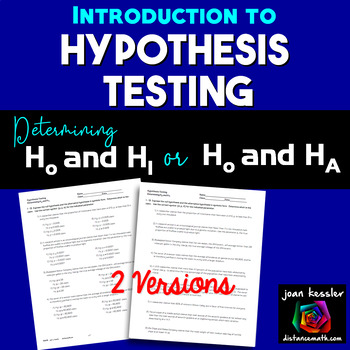Hypothesis Tests Introduction Statistics
- PDF
- Easel Activity
What educators are saying
Description
My Statistics students always had trouble setting up the Null Hypothesis and the Alternative Hypothesis, and without understanding this, the tests and interpretations cannot be determined properly. Now I explain the unit and what Hypothesis Testing is all about first, and start them off with this set of notes and problems. At first they are excited not to do any math or calculations, but then the challenge begins.
There are two sets of the problems, one multiple choice and the other mostly free response. There are 17 questions for which students determine the Null and Alternative Hypothesis in symbolic form and also determine which is the claim. Students can work alone or in pairs. Also included in this resource are notes with three examples and a student response sheet.
Note: Students are not testing the hypotheses, just setting up. You can, of course, go back to these examples at a later date to complete the tests.
Please note there are Two versions of the resource, one with H1 notation and the other using the HA notation. The preview only shows H1.
_______________________________________________________________
You may also like:
★ Hypothesis Testing Graphic Organizer
★ Confidence Intervals for a Proportion Task Cards
★ Confidence Intervals for the Mean on TI 83-84 plus Homework/ Quiz
★ Confidence Intervals for the Mean Task Cards plus Notes and Organizer
__________________________________________________
⇒ Click here to follow my TpT store to hear about my freebies, sales, and new products. Did you know that you can earn 5% back towards future purchases by leaving feedback? Your feedback is greatly appreciated.
If you have any questions or comments please contact me by email me at: joankessler@distancemath.com.
Connect with me:
✓ Join Joan's World of Math to access my Free Resource Library, and get news and updates
✓ Visit my Facebook Page
✓ Follow me on Instagram
LICENSING TERMS: The purchase of a license for this resource is for use by one teacher only for his or her students only. No part of this resource is to be shared with colleagues or used by an entire department, school, or district without purchasing the proper number of licenses. Please respect my hard work and do not share.
COPYRIGHT TERMS: ©2017 Joan Kessler (distancemath.com™). This resource may not be uploaded to the internet in any form, including classroom/personal websites or network drives, unless the site is password protected and can only be accessed by your students.






